Premier Inn Case Study: Organizational Structure, Factors, and Impact
VerifiedAdded on 2023/06/10
|8
|1855
|122
Case Study
AI Summary
This case study provides a comprehensive analysis of Premier Inn, a leading UK hospitality brand. It begins by examining Premier Inn's hierarchical organizational structure, detailing its benefits, such as clear information flow and defined roles, and drawbacks, including potential communication issues and departmental rivalry. The study then delves into the internal and external factors impacting the company, including a SWOT analysis that highlights strengths like profitability and brand image, and weaknesses like limited global presence, opportunities such as digital platform expansion, and threats like the impact of COVID-19. A PESTLE analysis further evaluates the macro-environmental factors, including political, economic, social, technological, legal, and environmental influences. The analysis considers the impact of COVID-19 on these factors, offering insights into the challenges and adaptations required for the hotel's operations and strategic planning. The case study concludes with references to relevant sources.
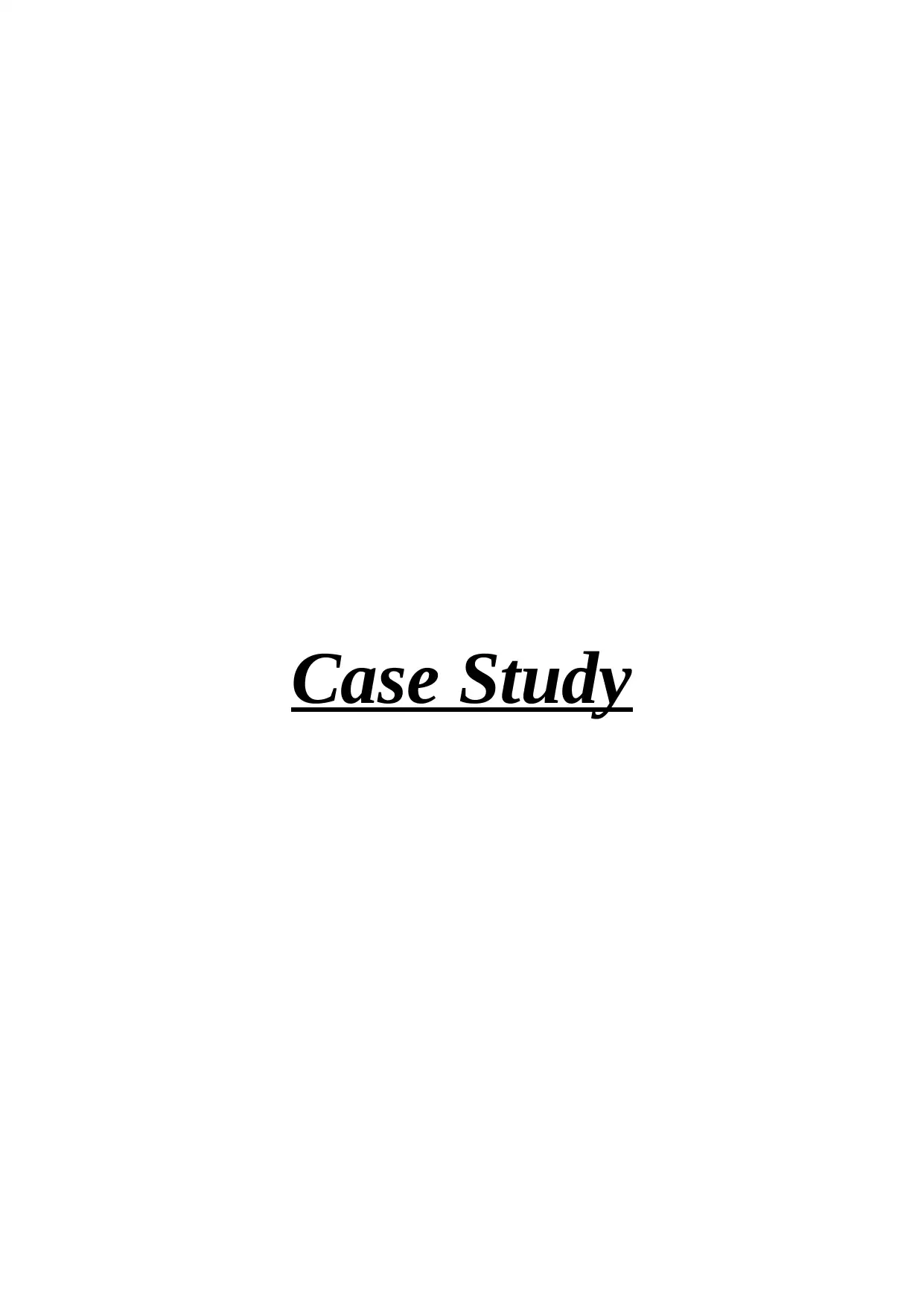
Case Study
Paraphrase This Document
Need a fresh take? Get an instant paraphrase of this document with our AI Paraphraser
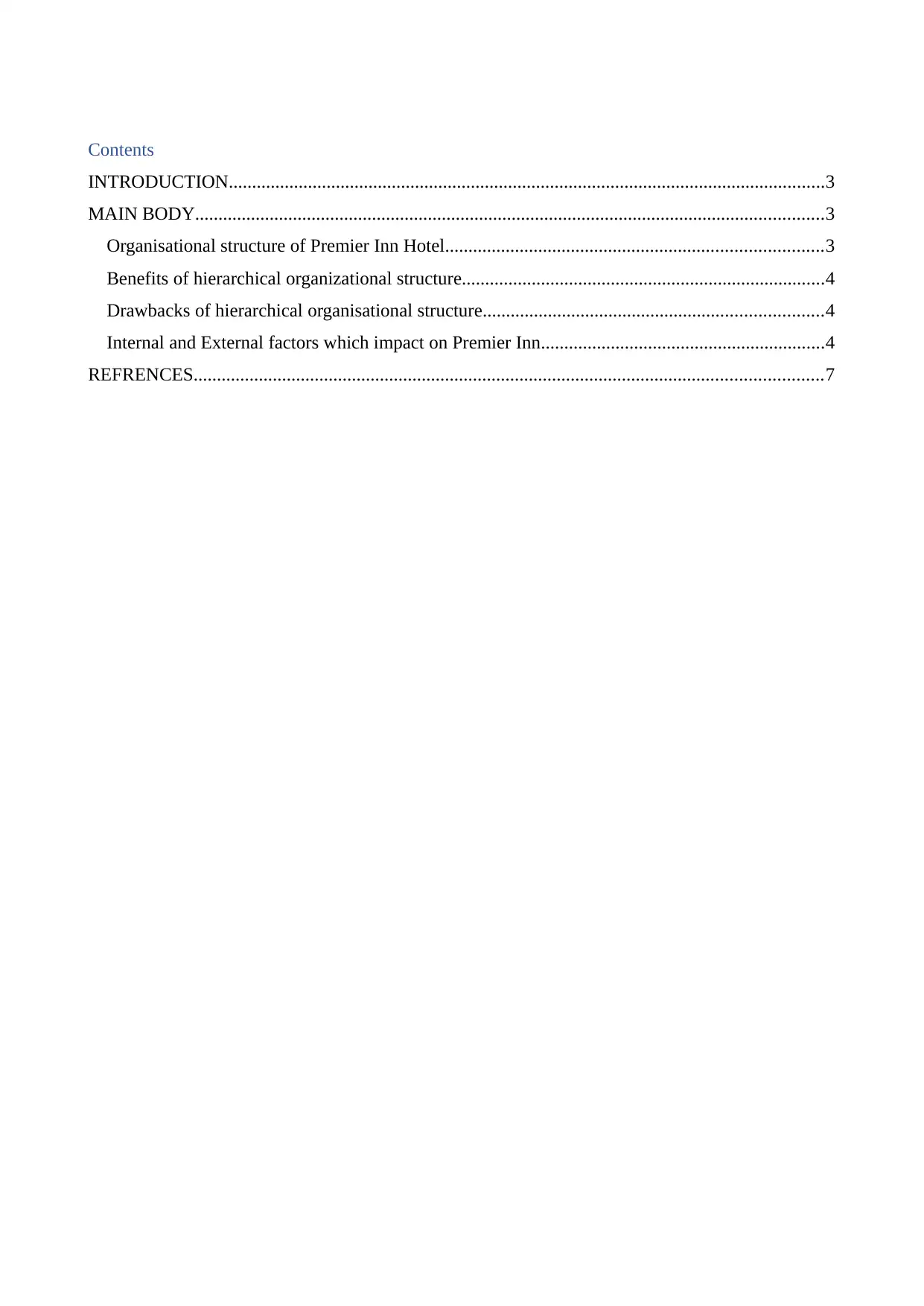
Contents
INTRODUCTION................................................................................................................................3
MAIN BODY.......................................................................................................................................3
Organisational structure of Premier Inn Hotel.................................................................................3
Benefits of hierarchical organizational structure..............................................................................4
Drawbacks of hierarchical organisational structure.........................................................................4
Internal and External factors which impact on Premier Inn.............................................................4
REFRENCES.......................................................................................................................................7
INTRODUCTION................................................................................................................................3
MAIN BODY.......................................................................................................................................3
Organisational structure of Premier Inn Hotel.................................................................................3
Benefits of hierarchical organizational structure..............................................................................4
Drawbacks of hierarchical organisational structure.........................................................................4
Internal and External factors which impact on Premier Inn.............................................................4
REFRENCES.......................................................................................................................................7
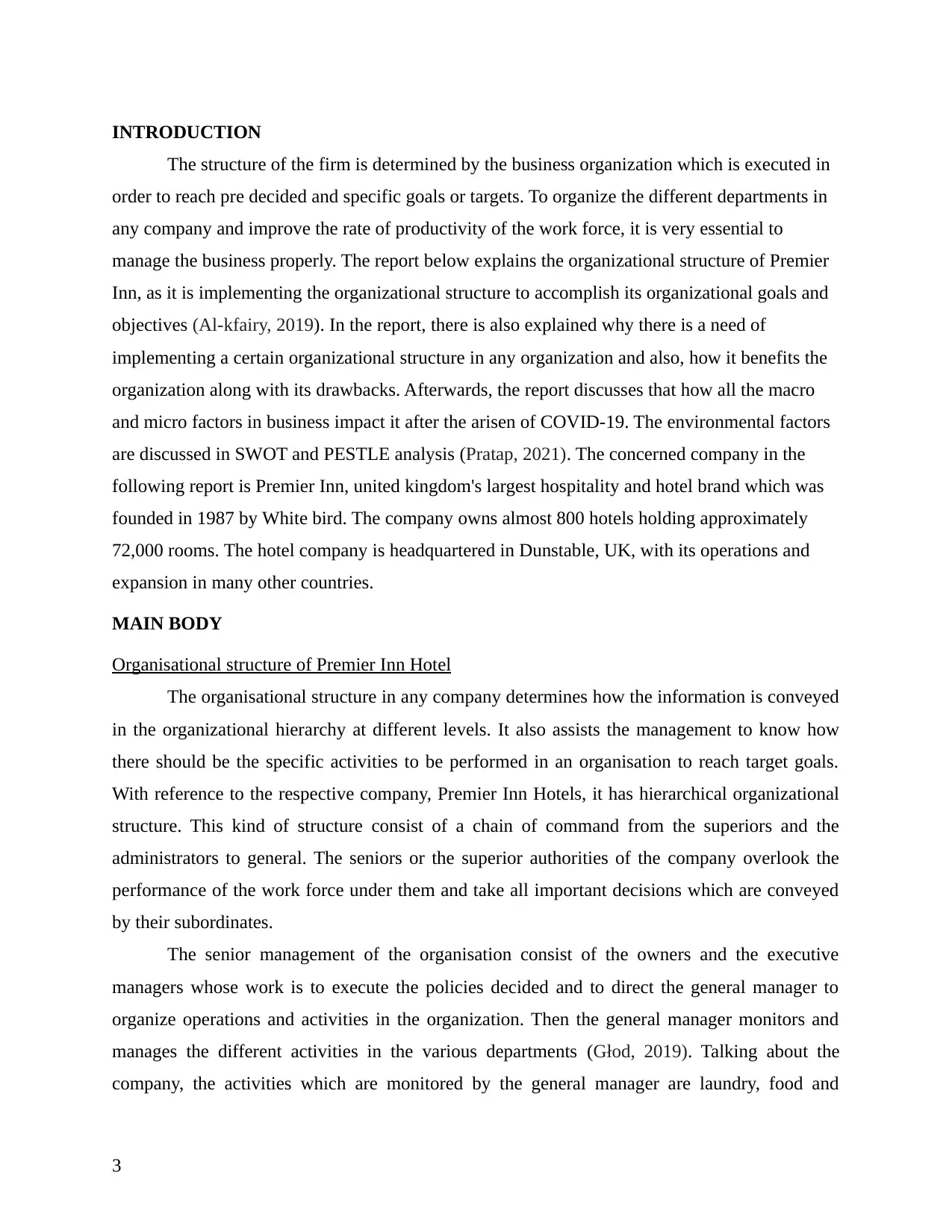
INTRODUCTION
The structure of the firm is determined by the business organization which is executed in
order to reach pre decided and specific goals or targets. To organize the different departments in
any company and improve the rate of productivity of the work force, it is very essential to
manage the business properly. The report below explains the organizational structure of Premier
Inn, as it is implementing the organizational structure to accomplish its organizational goals and
objectives (Al-kfairy, 2019). In the report, there is also explained why there is a need of
implementing a certain organizational structure in any organization and also, how it benefits the
organization along with its drawbacks. Afterwards, the report discusses that how all the macro
and micro factors in business impact it after the arisen of COVID-19. The environmental factors
are discussed in SWOT and PESTLE analysis (Pratap, 2021). The concerned company in the
following report is Premier Inn, united kingdom's largest hospitality and hotel brand which was
founded in 1987 by White bird. The company owns almost 800 hotels holding approximately
72,000 rooms. The hotel company is headquartered in Dunstable, UK, with its operations and
expansion in many other countries.
MAIN BODY
Organisational structure of Premier Inn Hotel
The organisational structure in any company determines how the information is conveyed
in the organizational hierarchy at different levels. It also assists the management to know how
there should be the specific activities to be performed in an organisation to reach target goals.
With reference to the respective company, Premier Inn Hotels, it has hierarchical organizational
structure. This kind of structure consist of a chain of command from the superiors and the
administrators to general. The seniors or the superior authorities of the company overlook the
performance of the work force under them and take all important decisions which are conveyed
by their subordinates.
The senior management of the organisation consist of the owners and the executive
managers whose work is to execute the policies decided and to direct the general manager to
organize operations and activities in the organization. Then the general manager monitors and
manages the different activities in the various departments (Głod, 2019). Talking about the
company, the activities which are monitored by the general manager are laundry, food and
3
The structure of the firm is determined by the business organization which is executed in
order to reach pre decided and specific goals or targets. To organize the different departments in
any company and improve the rate of productivity of the work force, it is very essential to
manage the business properly. The report below explains the organizational structure of Premier
Inn, as it is implementing the organizational structure to accomplish its organizational goals and
objectives (Al-kfairy, 2019). In the report, there is also explained why there is a need of
implementing a certain organizational structure in any organization and also, how it benefits the
organization along with its drawbacks. Afterwards, the report discusses that how all the macro
and micro factors in business impact it after the arisen of COVID-19. The environmental factors
are discussed in SWOT and PESTLE analysis (Pratap, 2021). The concerned company in the
following report is Premier Inn, united kingdom's largest hospitality and hotel brand which was
founded in 1987 by White bird. The company owns almost 800 hotels holding approximately
72,000 rooms. The hotel company is headquartered in Dunstable, UK, with its operations and
expansion in many other countries.
MAIN BODY
Organisational structure of Premier Inn Hotel
The organisational structure in any company determines how the information is conveyed
in the organizational hierarchy at different levels. It also assists the management to know how
there should be the specific activities to be performed in an organisation to reach target goals.
With reference to the respective company, Premier Inn Hotels, it has hierarchical organizational
structure. This kind of structure consist of a chain of command from the superiors and the
administrators to general. The seniors or the superior authorities of the company overlook the
performance of the work force under them and take all important decisions which are conveyed
by their subordinates.
The senior management of the organisation consist of the owners and the executive
managers whose work is to execute the policies decided and to direct the general manager to
organize operations and activities in the organization. Then the general manager monitors and
manages the different activities in the various departments (Głod, 2019). Talking about the
company, the activities which are monitored by the general manager are laundry, food and
3
⊘ This is a preview!⊘
Do you want full access?
Subscribe today to unlock all pages.

Trusted by 1+ million students worldwide
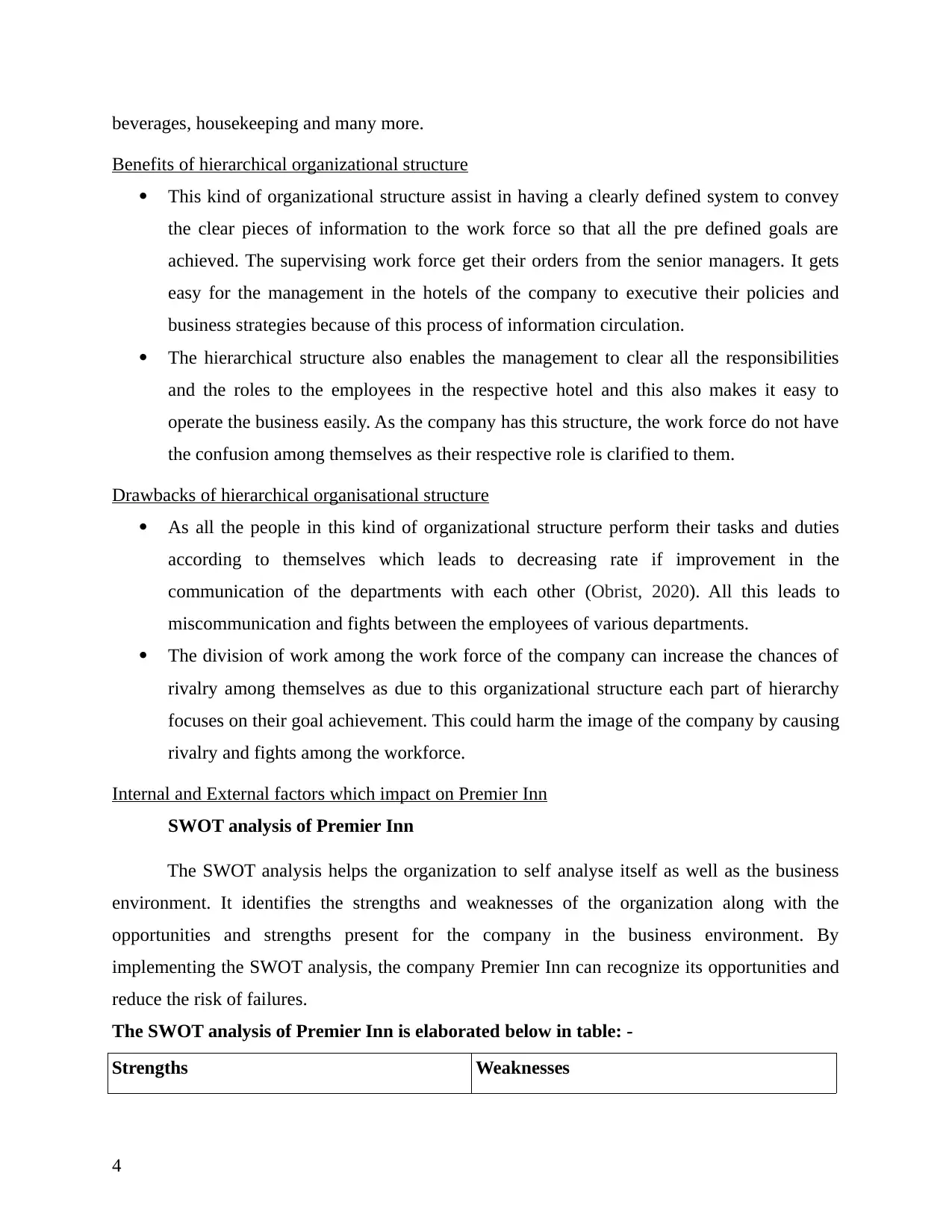
beverages, housekeeping and many more.
Benefits of hierarchical organizational structure
This kind of organizational structure assist in having a clearly defined system to convey
the clear pieces of information to the work force so that all the pre defined goals are
achieved. The supervising work force get their orders from the senior managers. It gets
easy for the management in the hotels of the company to executive their policies and
business strategies because of this process of information circulation.
The hierarchical structure also enables the management to clear all the responsibilities
and the roles to the employees in the respective hotel and this also makes it easy to
operate the business easily. As the company has this structure, the work force do not have
the confusion among themselves as their respective role is clarified to them.
Drawbacks of hierarchical organisational structure
As all the people in this kind of organizational structure perform their tasks and duties
according to themselves which leads to decreasing rate if improvement in the
communication of the departments with each other (Obrist, 2020). All this leads to
miscommunication and fights between the employees of various departments.
The division of work among the work force of the company can increase the chances of
rivalry among themselves as due to this organizational structure each part of hierarchy
focuses on their goal achievement. This could harm the image of the company by causing
rivalry and fights among the workforce.
Internal and External factors which impact on Premier Inn
SWOT analysis of Premier Inn
The SWOT analysis helps the organization to self analyse itself as well as the business
environment. It identifies the strengths and weaknesses of the organization along with the
opportunities and strengths present for the company in the business environment. By
implementing the SWOT analysis, the company Premier Inn can recognize its opportunities and
reduce the risk of failures.
The SWOT analysis of Premier Inn is elaborated below in table: -
Strengths Weaknesses
4
Benefits of hierarchical organizational structure
This kind of organizational structure assist in having a clearly defined system to convey
the clear pieces of information to the work force so that all the pre defined goals are
achieved. The supervising work force get their orders from the senior managers. It gets
easy for the management in the hotels of the company to executive their policies and
business strategies because of this process of information circulation.
The hierarchical structure also enables the management to clear all the responsibilities
and the roles to the employees in the respective hotel and this also makes it easy to
operate the business easily. As the company has this structure, the work force do not have
the confusion among themselves as their respective role is clarified to them.
Drawbacks of hierarchical organisational structure
As all the people in this kind of organizational structure perform their tasks and duties
according to themselves which leads to decreasing rate if improvement in the
communication of the departments with each other (Obrist, 2020). All this leads to
miscommunication and fights between the employees of various departments.
The division of work among the work force of the company can increase the chances of
rivalry among themselves as due to this organizational structure each part of hierarchy
focuses on their goal achievement. This could harm the image of the company by causing
rivalry and fights among the workforce.
Internal and External factors which impact on Premier Inn
SWOT analysis of Premier Inn
The SWOT analysis helps the organization to self analyse itself as well as the business
environment. It identifies the strengths and weaknesses of the organization along with the
opportunities and strengths present for the company in the business environment. By
implementing the SWOT analysis, the company Premier Inn can recognize its opportunities and
reduce the risk of failures.
The SWOT analysis of Premier Inn is elaborated below in table: -
Strengths Weaknesses
4
Paraphrase This Document
Need a fresh take? Get an instant paraphrase of this document with our AI Paraphraser
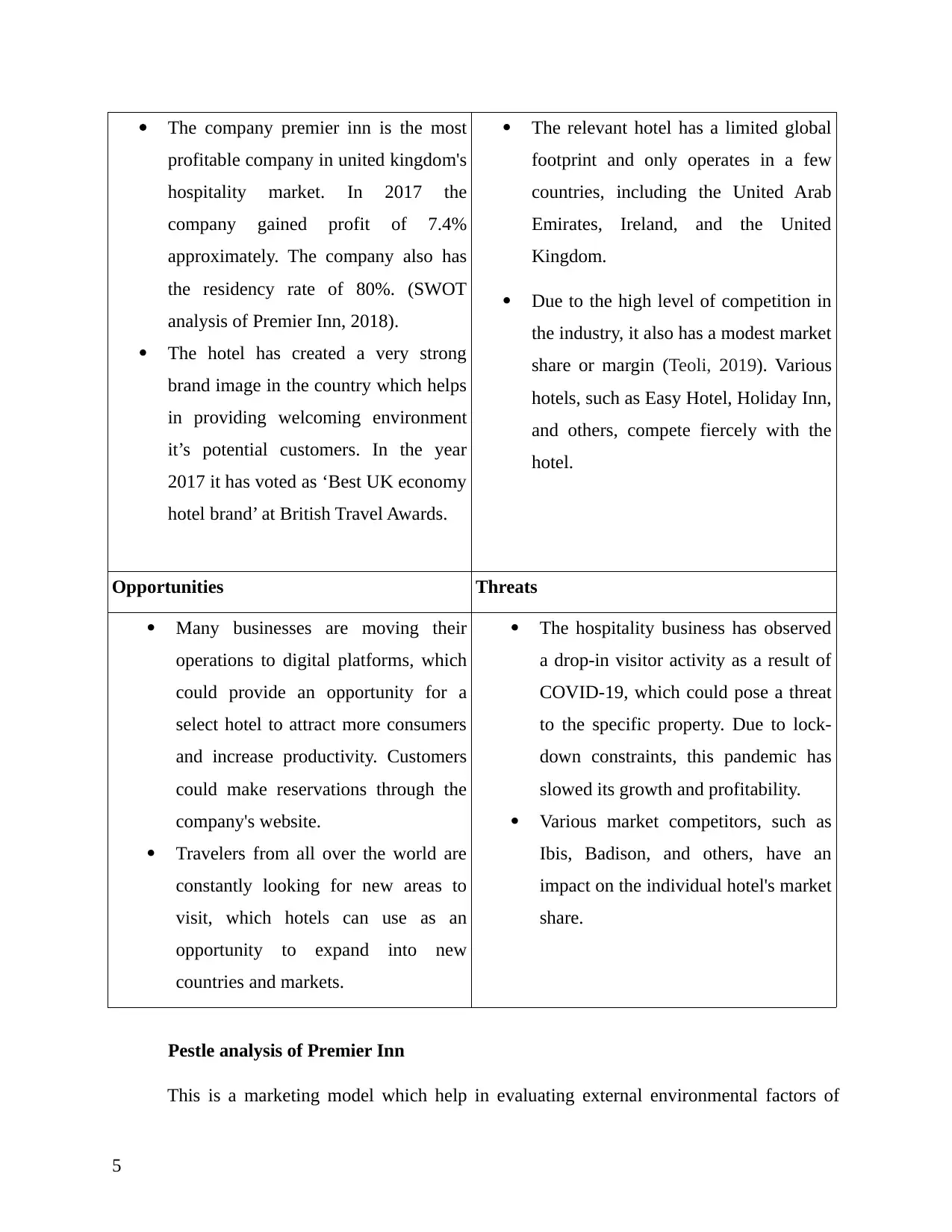
The company premier inn is the most
profitable company in united kingdom's
hospitality market. In 2017 the
company gained profit of 7.4%
approximately. The company also has
the residency rate of 80%. (SWOT
analysis of Premier Inn, 2018).
The hotel has created a very strong
brand image in the country which helps
in providing welcoming environment
it’s potential customers. In the year
2017 it has voted as ‘Best UK economy
hotel brand’ at British Travel Awards.
The relevant hotel has a limited global
footprint and only operates in a few
countries, including the United Arab
Emirates, Ireland, and the United
Kingdom.
Due to the high level of competition in
the industry, it also has a modest market
share or margin (Teoli, 2019). Various
hotels, such as Easy Hotel, Holiday Inn,
and others, compete fiercely with the
hotel.
Opportunities Threats
Many businesses are moving their
operations to digital platforms, which
could provide an opportunity for a
select hotel to attract more consumers
and increase productivity. Customers
could make reservations through the
company's website.
Travelers from all over the world are
constantly looking for new areas to
visit, which hotels can use as an
opportunity to expand into new
countries and markets.
The hospitality business has observed
a drop-in visitor activity as a result of
COVID-19, which could pose a threat
to the specific property. Due to lock-
down constraints, this pandemic has
slowed its growth and profitability.
Various market competitors, such as
Ibis, Badison, and others, have an
impact on the individual hotel's market
share.
Pestle analysis of Premier Inn
This is a marketing model which help in evaluating external environmental factors of
5
profitable company in united kingdom's
hospitality market. In 2017 the
company gained profit of 7.4%
approximately. The company also has
the residency rate of 80%. (SWOT
analysis of Premier Inn, 2018).
The hotel has created a very strong
brand image in the country which helps
in providing welcoming environment
it’s potential customers. In the year
2017 it has voted as ‘Best UK economy
hotel brand’ at British Travel Awards.
The relevant hotel has a limited global
footprint and only operates in a few
countries, including the United Arab
Emirates, Ireland, and the United
Kingdom.
Due to the high level of competition in
the industry, it also has a modest market
share or margin (Teoli, 2019). Various
hotels, such as Easy Hotel, Holiday Inn,
and others, compete fiercely with the
hotel.
Opportunities Threats
Many businesses are moving their
operations to digital platforms, which
could provide an opportunity for a
select hotel to attract more consumers
and increase productivity. Customers
could make reservations through the
company's website.
Travelers from all over the world are
constantly looking for new areas to
visit, which hotels can use as an
opportunity to expand into new
countries and markets.
The hospitality business has observed
a drop-in visitor activity as a result of
COVID-19, which could pose a threat
to the specific property. Due to lock-
down constraints, this pandemic has
slowed its growth and profitability.
Various market competitors, such as
Ibis, Badison, and others, have an
impact on the individual hotel's market
share.
Pestle analysis of Premier Inn
This is a marketing model which help in evaluating external environmental factors of
5
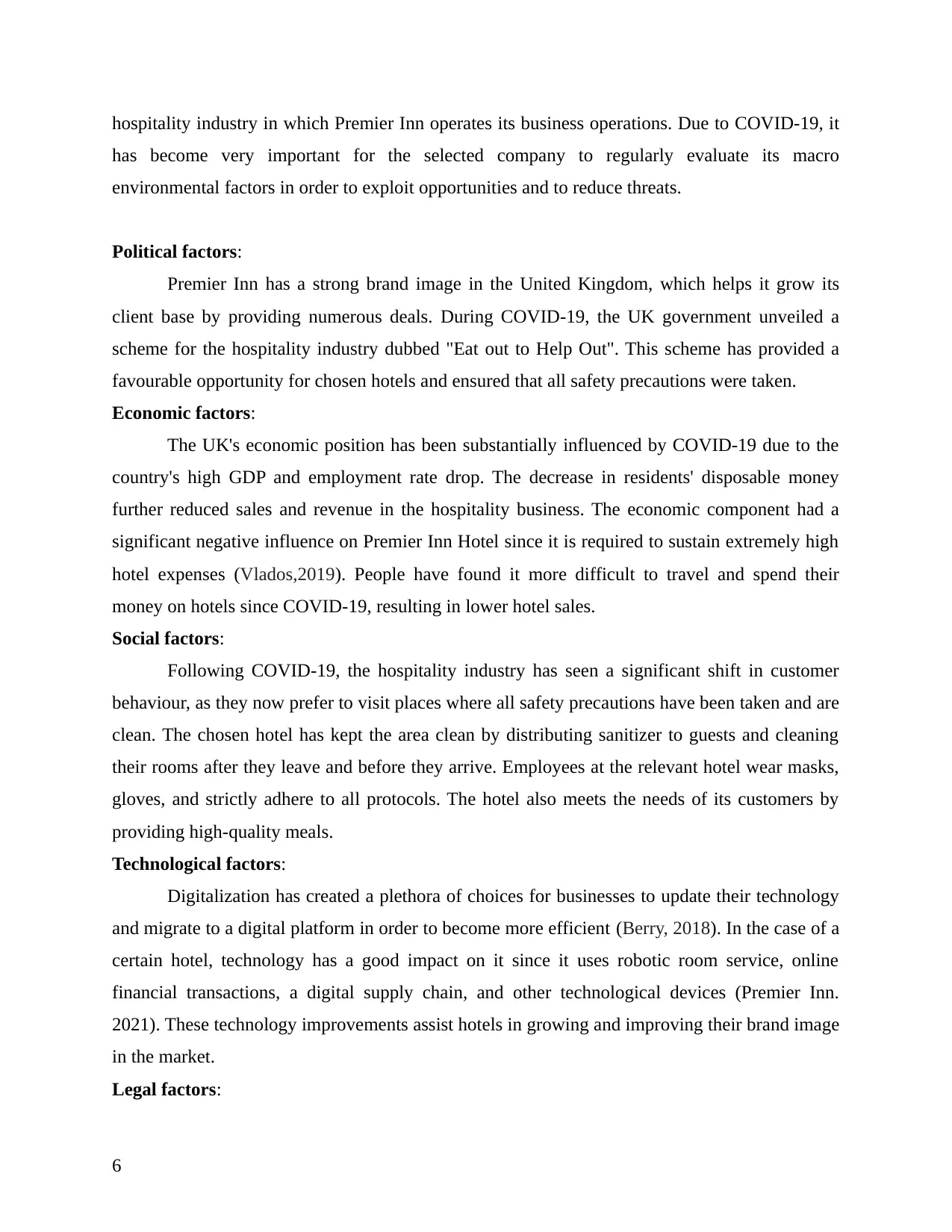
hospitality industry in which Premier Inn operates its business operations. Due to COVID-19, it
has become very important for the selected company to regularly evaluate its macro
environmental factors in order to exploit opportunities and to reduce threats.
Political factors:
Premier Inn has a strong brand image in the United Kingdom, which helps it grow its
client base by providing numerous deals. During COVID-19, the UK government unveiled a
scheme for the hospitality industry dubbed "Eat out to Help Out". This scheme has provided a
favourable opportunity for chosen hotels and ensured that all safety precautions were taken.
Economic factors:
The UK's economic position has been substantially influenced by COVID-19 due to the
country's high GDP and employment rate drop. The decrease in residents' disposable money
further reduced sales and revenue in the hospitality business. The economic component had a
significant negative influence on Premier Inn Hotel since it is required to sustain extremely high
hotel expenses (Vlados,2019). People have found it more difficult to travel and spend their
money on hotels since COVID-19, resulting in lower hotel sales.
Social factors:
Following COVID-19, the hospitality industry has seen a significant shift in customer
behaviour, as they now prefer to visit places where all safety precautions have been taken and are
clean. The chosen hotel has kept the area clean by distributing sanitizer to guests and cleaning
their rooms after they leave and before they arrive. Employees at the relevant hotel wear masks,
gloves, and strictly adhere to all protocols. The hotel also meets the needs of its customers by
providing high-quality meals.
Technological factors:
Digitalization has created a plethora of choices for businesses to update their technology
and migrate to a digital platform in order to become more efficient (Berry, 2018). In the case of a
certain hotel, technology has a good impact on it since it uses robotic room service, online
financial transactions, a digital supply chain, and other technological devices (Premier Inn.
2021). These technology improvements assist hotels in growing and improving their brand image
in the market.
Legal factors:
6
has become very important for the selected company to regularly evaluate its macro
environmental factors in order to exploit opportunities and to reduce threats.
Political factors:
Premier Inn has a strong brand image in the United Kingdom, which helps it grow its
client base by providing numerous deals. During COVID-19, the UK government unveiled a
scheme for the hospitality industry dubbed "Eat out to Help Out". This scheme has provided a
favourable opportunity for chosen hotels and ensured that all safety precautions were taken.
Economic factors:
The UK's economic position has been substantially influenced by COVID-19 due to the
country's high GDP and employment rate drop. The decrease in residents' disposable money
further reduced sales and revenue in the hospitality business. The economic component had a
significant negative influence on Premier Inn Hotel since it is required to sustain extremely high
hotel expenses (Vlados,2019). People have found it more difficult to travel and spend their
money on hotels since COVID-19, resulting in lower hotel sales.
Social factors:
Following COVID-19, the hospitality industry has seen a significant shift in customer
behaviour, as they now prefer to visit places where all safety precautions have been taken and are
clean. The chosen hotel has kept the area clean by distributing sanitizer to guests and cleaning
their rooms after they leave and before they arrive. Employees at the relevant hotel wear masks,
gloves, and strictly adhere to all protocols. The hotel also meets the needs of its customers by
providing high-quality meals.
Technological factors:
Digitalization has created a plethora of choices for businesses to update their technology
and migrate to a digital platform in order to become more efficient (Berry, 2018). In the case of a
certain hotel, technology has a good impact on it since it uses robotic room service, online
financial transactions, a digital supply chain, and other technological devices (Premier Inn.
2021). These technology improvements assist hotels in growing and improving their brand image
in the market.
Legal factors:
6
⊘ This is a preview!⊘
Do you want full access?
Subscribe today to unlock all pages.

Trusted by 1+ million students worldwide
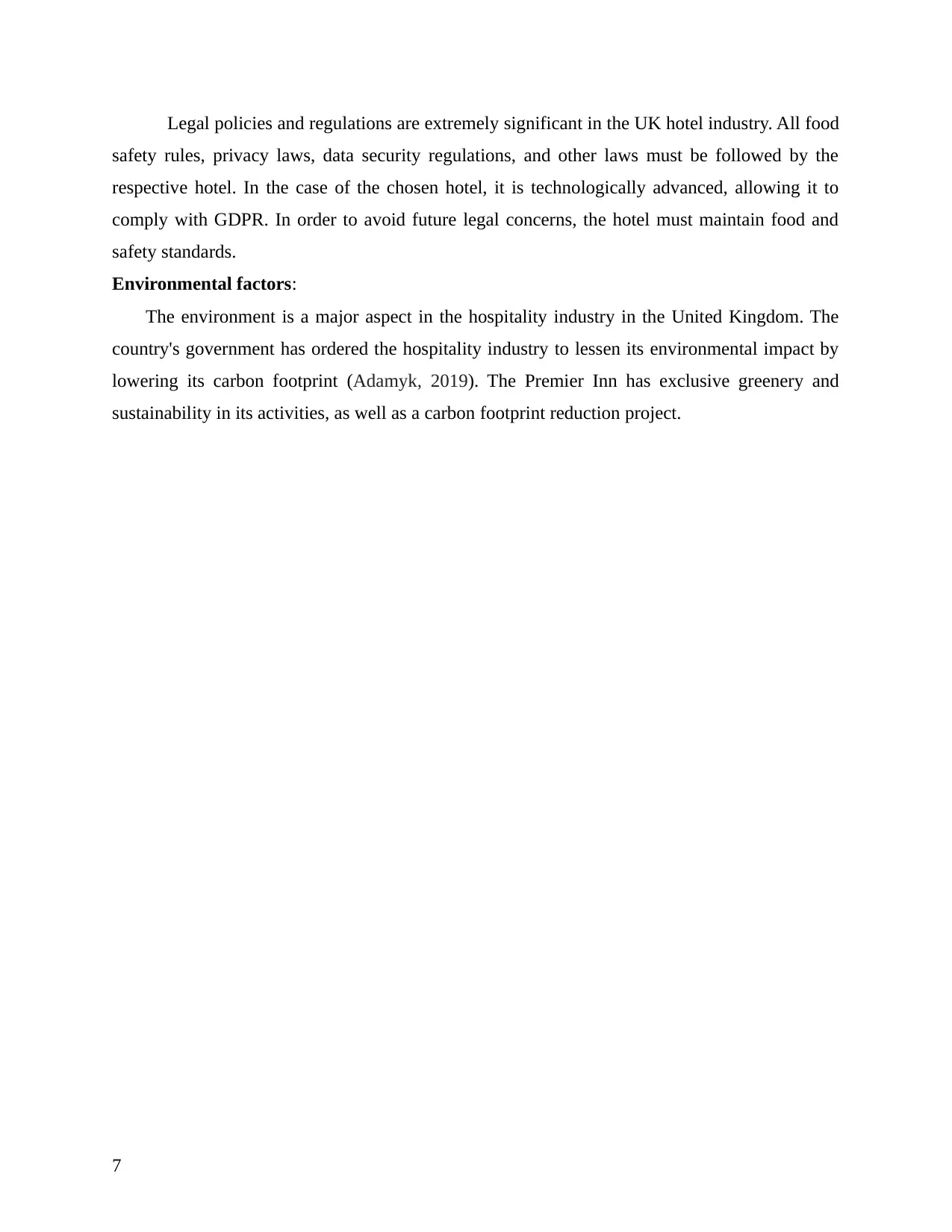
Legal policies and regulations are extremely significant in the UK hotel industry. All food
safety rules, privacy laws, data security regulations, and other laws must be followed by the
respective hotel. In the case of the chosen hotel, it is technologically advanced, allowing it to
comply with GDPR. In order to avoid future legal concerns, the hotel must maintain food and
safety standards.
Environmental factors:
The environment is a major aspect in the hospitality industry in the United Kingdom. The
country's government has ordered the hospitality industry to lessen its environmental impact by
lowering its carbon footprint (Adamyk, 2019). The Premier Inn has exclusive greenery and
sustainability in its activities, as well as a carbon footprint reduction project.
7
safety rules, privacy laws, data security regulations, and other laws must be followed by the
respective hotel. In the case of the chosen hotel, it is technologically advanced, allowing it to
comply with GDPR. In order to avoid future legal concerns, the hotel must maintain food and
safety standards.
Environmental factors:
The environment is a major aspect in the hospitality industry in the United Kingdom. The
country's government has ordered the hospitality industry to lessen its environmental impact by
lowering its carbon footprint (Adamyk, 2019). The Premier Inn has exclusive greenery and
sustainability in its activities, as well as a carbon footprint reduction project.
7
Paraphrase This Document
Need a fresh take? Get an instant paraphrase of this document with our AI Paraphraser
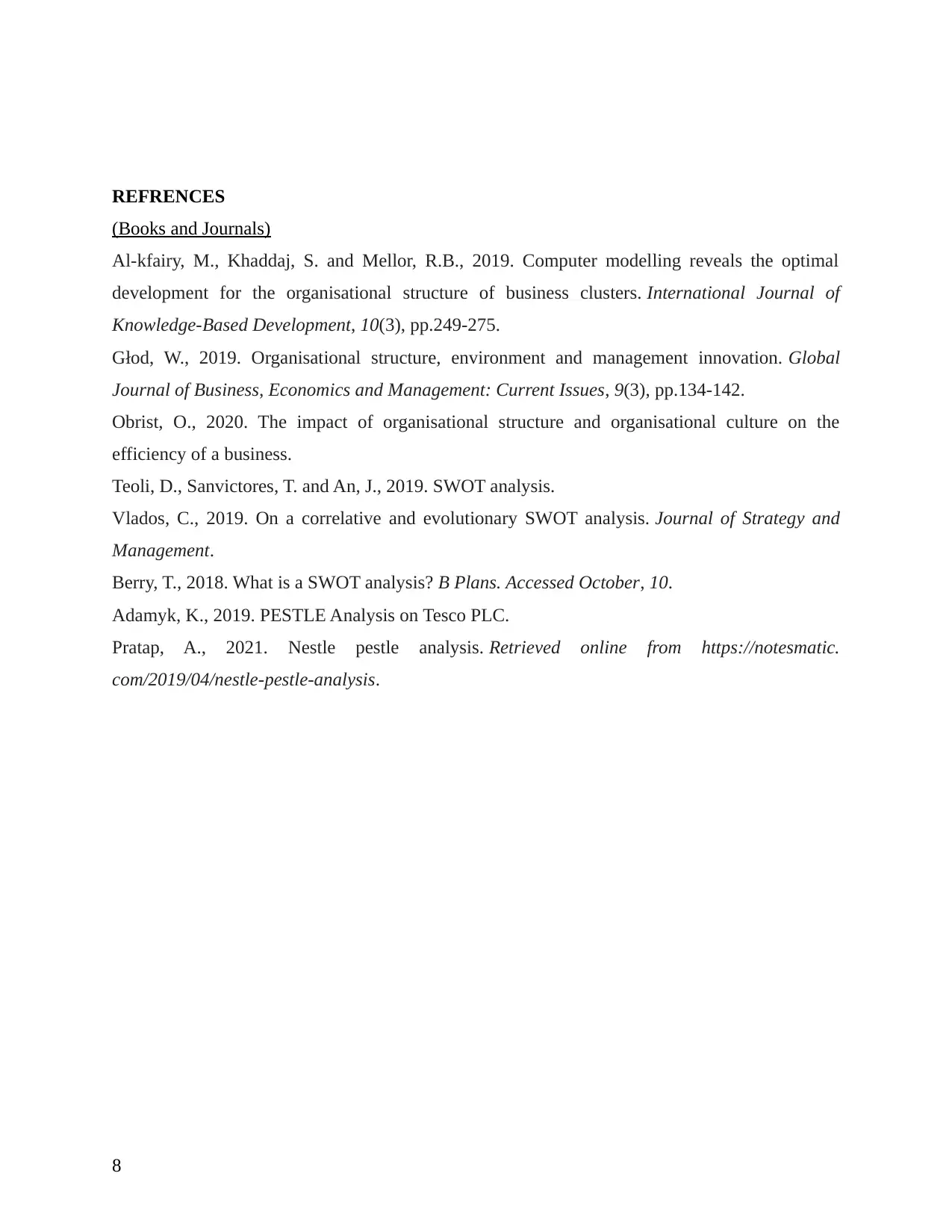
REFRENCES
(Books and Journals)
Al-kfairy, M., Khaddaj, S. and Mellor, R.B., 2019. Computer modelling reveals the optimal
development for the organisational structure of business clusters. International Journal of
Knowledge-Based Development, 10(3), pp.249-275.
Głod, W., 2019. Organisational structure, environment and management innovation. Global
Journal of Business, Economics and Management: Current Issues, 9(3), pp.134-142.
Obrist, O., 2020. The impact of organisational structure and organisational culture on the
efficiency of a business.
Teoli, D., Sanvictores, T. and An, J., 2019. SWOT analysis.
Vlados, C., 2019. On a correlative and evolutionary SWOT analysis. Journal of Strategy and
Management.
Berry, T., 2018. What is a SWOT analysis? B Plans. Accessed October, 10.
Adamyk, K., 2019. PESTLE Analysis on Tesco PLC.
Pratap, A., 2021. Nestle pestle analysis. Retrieved online from https://notesmatic.
com/2019/04/nestle-pestle-analysis.
8
(Books and Journals)
Al-kfairy, M., Khaddaj, S. and Mellor, R.B., 2019. Computer modelling reveals the optimal
development for the organisational structure of business clusters. International Journal of
Knowledge-Based Development, 10(3), pp.249-275.
Głod, W., 2019. Organisational structure, environment and management innovation. Global
Journal of Business, Economics and Management: Current Issues, 9(3), pp.134-142.
Obrist, O., 2020. The impact of organisational structure and organisational culture on the
efficiency of a business.
Teoli, D., Sanvictores, T. and An, J., 2019. SWOT analysis.
Vlados, C., 2019. On a correlative and evolutionary SWOT analysis. Journal of Strategy and
Management.
Berry, T., 2018. What is a SWOT analysis? B Plans. Accessed October, 10.
Adamyk, K., 2019. PESTLE Analysis on Tesco PLC.
Pratap, A., 2021. Nestle pestle analysis. Retrieved online from https://notesmatic.
com/2019/04/nestle-pestle-analysis.
8
1 out of 8
Related Documents
Your All-in-One AI-Powered Toolkit for Academic Success.
+13062052269
info@desklib.com
Available 24*7 on WhatsApp / Email
![[object Object]](/_next/static/media/star-bottom.7253800d.svg)
Unlock your academic potential
Copyright © 2020–2025 A2Z Services. All Rights Reserved. Developed and managed by ZUCOL.

